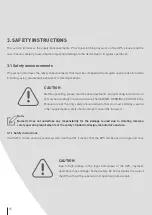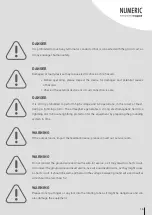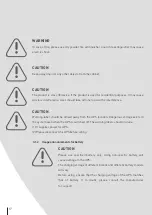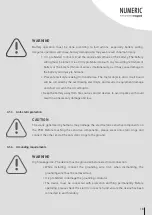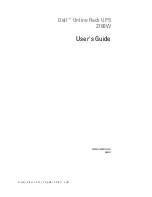
6
2.2 Working principle
2.2.1
Working principle diagram
Figure 2-1. Working principle diagram
2.2.2 Working mode
There are 4 working modes of the UPS: normal mains mode, battery mode, bypass mode and
maintenance bypass mode.
Normal mains mode
When the mains is in normal mode, AC power is transformed to DC power by PFC, and supplies power
to the inverter. While rectifying the AC power into DC power, the rectifier eliminates the abnormal noise
wave, noise and unstable frequency, making the inverter provide stable and clean power for load. The
specific work process is as follows:
• When mains is normal, the rectifier, inside the power unit, rectifies the mains into anode and
cathode DC voltage and stores energy in DC electrolysis for the inverter to use. The inverter absorbs
energy from DC electrolysis and inverts to a stable output at 220 Vac voltage. When the system
control card detects the inverter is normal, it will supply the inverting voltage to load.
Battery mode
When mains is abnormal, system will switch to battery input, the Boost circuit promotes the battery
voltage to a certain value and then supplies the DC power to the inverter, that makes the AC output
without interruption and protects the load. The specific work process is as follows:
• When mains is abnormal at any time, the rectifier will switch to battery input immediately to
maintain the voltage of DC electrolysis, which guarante the inverter without power down. Before the
battery discharges completely, if the mains recovers, the rectifier will switch to mains input and
charge battery at the same time. During the switch between grid power supply and battery power
supply, the inverter output cannot power down.
• In battery power supply mode, if mains does not recover normally during the time, and the battery
energy is running out, the UPS will send sound and light alarm, stop working at maximum
discharge point and emit long beeps. At that time, the load will power down.
Bypass mode
When system is abnormal (such as over-temperature, short-circuit, output voltage abnormal or
overload) and exceed the bearable range, the inverter will shut down automatically to avoid damage.
If mains is still normal at this time, it will turn to bypass to supply power for load. The specific work
process is as follows:
• If the inverter circuit fault or inverter overload exceed the bearable range, the UPS will turn to
bypass to output. During bypass power supply, if fault or overload is removed, the UPS will start
inverter and begin to supply power for load. When the load is serious and exceeds the bypass
bearable range, the UPS will close the bypass output, and will cause user load power down. When
load fault or short circuit, the UPS will switch to bypass to supply power from inverter. If the short
circuit is serious, the UPS input breaker and bypass breaker may trip out. After the short circuit
fault, UPS will try to restart. If the short circuit is removed, the UPS will switch to inverter; if not
removed, the UPS will try to restart for 5 times. Five minutes later, the UPS will turn to fault
protection. At this time, power off or press the touch screen to shut down the UPS, and restart the
UPS to work normally.
Bypass Input
Maintenance bypass
Bypass unit
Power unit
Mains Input
Battery Input
Output
Bypass unit
Power unit
AC
DC
AC
DC
DC
DC






















